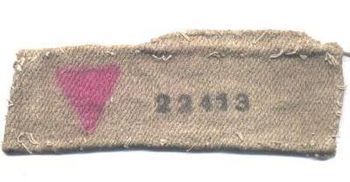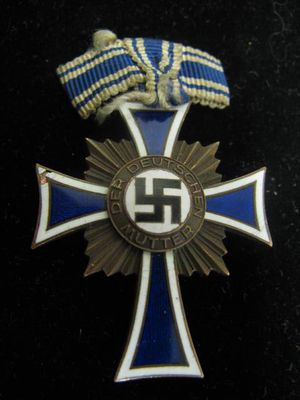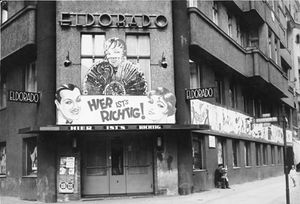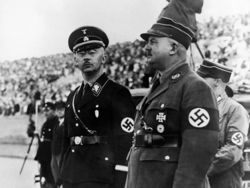Why did Germany Persecute LGBT people during World War II
In Hitler's Germany, the ideal Aryan male was stereotyped as being strong, handsome, fanatical about his appearance, and obsessed with youth. The ideal homosexual was stereotyped as being strong, handsome, fanatical about his appearance, and obsessed with youth. The only overt distinction between these two groups of men was their sexual proclivity; which was not exclusive to one group. Many members of the National Socialist party were openly gay or bisexual which seemed to be of little significance to Adolph Hitler. The “Gay Holocaust”; therefore, was not as a result of Hitler’s supposed homophobia. Rather, the persecution of homosexuals in Germany was primarily rooted in the fascist ideology of pro-natalism.
The principal goal of National Socialism's philosophy was to create a pure Aryan race in order to populate Germany. Hitler took this one step further with his fixation on Lebensraum, or “Living Space” for the German people. The needs of the nation far outweighed the needs of the individual thus pro-natalist propaganda was employed as a means to encourage people to produce offspring. The concern of key members of the Reich was that two million men, potential fathers, were lost during the Great War. The lost soldiers were imagined as prototypical Aryan men who needed to be replaced. The insistence of Party members to re-establish the myth of the ideal Aryan male resulted in renewed interest of the gay "problem."
Pro-Natalism
Prominent National Socialist lawyer Hans Frank warned the German people in 1935 that the “epidemic of homosexuality was threatening the new Reich.” [1] Expanding on Frank's premise, Heinrich Himmler made a speech to SS commanders on February 18, 1937 noting that the two million men lost during the Great War and the reported two million homosexual German men had detrimental effects on German society. Himmler concluded that since four million men were no longer procreating homosexuality was to become a state matter. He pronounced that “All things which take place in the sexual sphere are not the private affair of the individual, but signify the life and death of the nation.”[2] With such a pronouncement, the SS and local police departments intensified their search for those members of society who they deemed detrimental to the regeneration of the Aryan family. The Reich believed producing pure German offspring was the key to the future success of Germany.
On June 4, 1933, less than six months after Hitler became Chancellor of Germany, the program of “Matrimonial Credits” was introduced. Under this program, parents received 125 marks per child produced.[3] The Reich's propaganda focused on depicting reproduction as a national duty and honored women who produced numerous offspring. If a woman produced either nine total children or seven male offspring she received the Cross of Honour of the German Mother; the highest possible honor bestowed upon women. Pure German women who produced superior children were revered in the Reich, yet those who were likely to produce “inferior” children became victims of the sterilization program and later Aktion T4; the state sanctioned murdering of those deemed unfit to reproduce.
In the early and mid-1930’s, several laws were enacted to insure the preservation of pure and superior Aryan blood to provide for the future of the nation. In 1934, the Marriage Law was enacted which required couples to provide proof that their potential offspring were immune from any disabling diseases through heredity. The National Socialists were so concerned with the threat of a racially inferior German society, they rounded up and sterilized gypsies and homosexuals under the heading of "deviant asocials." Ironically, a decade prior to this program, homosexuals enjoyed an open and vibrant life in Berlin, which was arguably the most gay-friendly city in the world at the time.
Gay Life in Germany
During the Weimar Republic of the 1920’s, the gay nightlife was at its peak in Berlin. “Bars for homosexuals” and “cafes where men danced with men” were "accepted as part of the new life.”[4] At a time when there were more than 2,000 known male prostitutes, civil servants, sailors, and government officials were among the throngs who frequented the numerous gay bars. One of the leading proponents of the gay liberation movement in Berlin was researcher Magnus Hirschfeld. He opened the Institute for Sexual Research on July 1, 1919 and tried numerous times to get a bill to the Reichstag to retract Paragraph 175; a law that defined homosexuality as criminal behavior.
Paragraph 175 was first put into law in 1871 after Germany’s reunification. Hirschfeld believed that the liberal Weimar government might seriously consider repealing the law. In 1929; however, National Socialist deputies in the Reichstag Assembly averred that Jews were to blame for the homosexual problem in Germany in an attempt to “undermine the morality of the German people.”[5] Hitler responded to Hirschfeld’s efforts in the same manner. In a letter published August 2, 1930 by the fascist friendly newspaper, the Volktscher Beobachter, Hitler wrote that “Jews are forever trying to propagandize sexual relations between siblings, men and animals, and men and men.”[6] Although historically indifferent to homosexuality until the early 1930’s, Hitler felt it necessary to advance his theory that Jews were to blame for the decline of Germany. Three months after attaining the position of Chancellor, Hitler passed the Enabling Act, which eliminated the Weimar Constitution and gave the Fuhrer unchallenged control of Germany. Less than three months hence, on May 6, 1933, the Hirschfeld Institute was seized and all photographs and books were burned in an effort to rid the nation of non-Germanic culture. Also in 1933, laws were enacted which banned all pornography and homosexual rights groups and organizations. The gay life in Germany was waning in force and the decisive blow to the liberty in Germany came during the “Night of Long Knives.”
Rohm and Himmler
Ernst Rohm, the leader of Hitler’s storm troopers known as the SA, was assassinated on June 30, 1934. Rohm was openly homosexual. June 28, 1934 marked the beginning of a five day event known as “The Night of Long Knives” or the “Blood Purge.” This hideous endeavor was sanctioned by Hitler after he received erroneous information from Heinrich Himmler that Rohm was trying to usurp power from the Fuhrer. Himmler, who was extremely homophobic, despised Rohm as he was his rival for Hitler’s esteem. Himmler also wanted to expand the fledgling SS and in order to do so had to dismantle to powerful SA. The only means by which to do this was for Rohm to be eliminated. As Rohm had long been Hitler’s closest ally and the Chancellor was indifferent to his homosexuality, Himmler had to concoct a scheme to enrage the Fuhrer. He manufactured evidence that supported his claim that Rohm was trying to undermine Hitler’s authority. This was the catalyst needed for Hitler to order Rohm’s assassination. Rohm, along with three hundred other men, was murdered in Munich in the summer of 1934; Himmler became the second most powerful man in Hitler's regime.[7]
Less than three weeks after orchestrating the murder of Rohm, Himmler held sole control of the newly independent SS. Also during that period, Hitler issued a directive that all homosexuals were to be expelled from the ranks of the SA and SS. He delivered a statement to the people of Germany stating that he would like “every mother to be able to offer her son to the SA, the Party, or the Hitler Youth without the fear that he might become morally or sexually depraved.”[8] Prior to the Rohm assassination, Hitler had little to say about gays and lesbians, but with Himmler’s urging and the constant obsession of pro-natalistic thinking, the issue became more prevalent to the Fuhrer and heightened measures were taken to stamp out homosexuality.
On February 18, 1937, Himmler voiced his disgust with the relatively high number of homosexual cases within his own ranks. He naively declared that there were “eight to ten cases a year” of homosexual activity within the SS.[9] His tolerance had worn out thus prompting him to proclaim that any member of the SS participating in such an act was to be publically degraded, sent to prison, and finally transported to a concentration camp where he would be “shot….while attempting to escape.”[10] Four years prior to this declaration, Himmler rejected the fascist notion that all traits and behaviors were genetic and thought scientists were wrong in their theories that homosexuality was congenital. He wrongly believed that 98% of those who had participated in a homosexual act were seduced and that the issue was resolvable through discipline and hard labor.[11]
Treatment in the Camps
Homosexuals who were sentenced to suffer in a camp received especially harsh treatment from both the guards and in some cases fellow prisoners. As the pursuit of gay men intensified throughout the 1930’s and early 1940’s, most gay men in German society were afraid of contacting one another for fear of arrest and prosecution. This practice was continued inside the concentration camps; therefore, a cohesive and supportive group network was not formed among gay prisoners as it was within so many other classifications of prisoners. It is arguable that the ensuing feeling of isolation contributed to the early death of homosexuals in concentration camps. Most gay men died within one year of arriving at a camp.[12] In Buchenwald they were victims of Dr. Carl Vaernet’s experimentation, which included the implantation of subcutaneous testosterone capsules and castration, and more often than not died as a result.
At other camps, such as Dachau, they were worked to death. They were treated in camps as they were in ordinary society, thus had to endure the name calling and scrutiny at a greater level than other prisoners.[13] While homosexuals had to avoid contact with other male prisoners, those incarcerated for criminal behavior or as political enemies engaged freely in homosexual activity on their specific blocks. Although these camps were said to be for the reeducation of homosexuals, the percentage of deaths among gay men was second only to that of Jewish prisoners. Throughout the entire system of concentration and extermination camps, the death rate among homosexuals was an astounding 53%; political prisoners had a death tally of over 40%, while Jehovah’s Witnesses suffered an almost 35% loss in the camps.[14] Perhaps the saddest aspect of homosexual persecution under the Reich was that once the camps were liberated by the Allies, many homosexual prisoners had to remain imprisoned. Paragraph 175 was still in effect and these men who thought themselves to be liberated in 1945, remained prisoners in Germany.
Conclusion
Pro-natalism was a campaign designed to promote reproduction among German people. Paragraph 175 was a law enacted in 1871 and revised in 1935 to include a broader spectrum as to what defined sexual deviancy; any presumed physical intimacy between men was thought to be a criminal offense. Curiously, Paragraph 175 only pertained to German and Austrian males. All females were exempt from the law and those in violation who were not of German ancestry were simply deported from the country. This enhances the argument that the persecution of homosexuals was based solely on the desire of Hitler to repopulate a pure German race. The law did not apply to any country under German occupation during the war; only Germany and Austria were affected as these countries were deemed by Hitler to be the home of a pure Nordic race. Hitler’s actions regarding homosexuals were based on his racist agenda, which he applied to his pro-natalist beliefs.
Related DailyHistory.org Articles
- What were the goals of the Axis powers and the Soviet Union during World War Two?
- How Did the German Military Develop Blitzkrieg?
- Why did Operation Market Garden in 1944 fail?
- How did Mussolini become Prime Minister of Italy?
- How did Adolf Hitler become the Fuhrer of Germany?
- Why did Germany lose the Battle of Stalingrad?
References
- ↑ Richard Plant, The Pink Triangle (New York: Henry Holt and Company, 1986), 26.
- ↑ Ben S. Austin, “Homosexuals and the Holocaust,” Middle Tennessee State University, http://www.mtsu.edu/~baustin/homobg.html (accessed December 2, 2011).
- ↑ Plant, 210.
- ↑ Frank Rector, The N a z i Extermination of Homosexuals (New York: Stein and Day, 1981), 14.
- ↑ Austin, “Homosexuals and the Holocaust.”
- ↑ Plant, The Pink Triangle, 49.
- ↑ Plant, The Pink Triangle, 54-64. These pages contain Plant’s theory on political motivation along with a detailed description of the “Night of Long Knives.” It is important to understand that Rohm’s assassination was politically motivated and not due to his homosexuality.
- ↑ Geoffrey J. Giles, “The Institutionalization of Homosexual Panic in the Third Reich,” in Social Outsiders in N a z i Germany, edited by Robert Gellately and Nathan Stoltzfus, 233-255. (Princeton: Princeton University Press, 2001), 236.
- ↑ Austin
- ↑ Austin
- ↑ Giles, 243.
- ↑ Austin
- ↑ Ruediger Lautmann, “Gay prisoners in Concentration Camps as Compared with Jehovah’s Witnesses and Political Prisoners,” Middle Tennessee State University, http://www.mtsu.edu/~baustin/lautmann.html/ (accessed December 2, 2011).
- ↑ Lautmann
Admin and EricLambrecht




